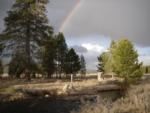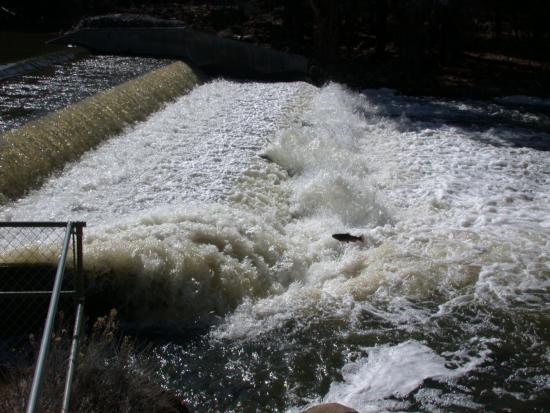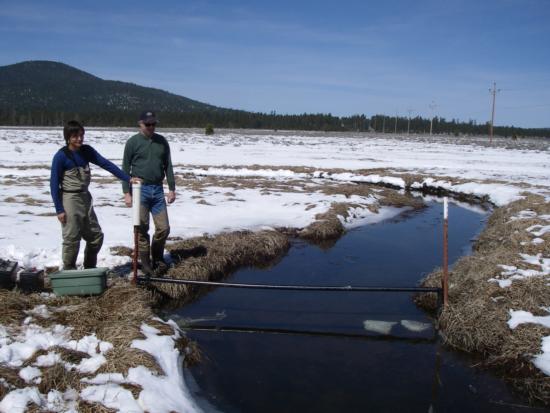Restoration of Wild Eagle Lake Rainbow Trout
-
IssuePine Creek historically provided critical spawning and rearing habitat for Eagle Lake rainbow trout. Over the past 100+ years modifications of Pine Creek watershed decoupled the trout from its stream habitat. After 20+ years of restoration efforts in the Pine Creek watershed, a key question is, are rainbow trout able to migrate to the headwaters of Pine Creek?

-
Objectives
Over the past 100+ years modifications of Pine Creek watershed (e.g., overgrazing, timber harvest, passage barriers, culverts) decoupled the trout from its stream habitat. Introduced brook trout now dominate historic rearing areas in the upper watershed. Passage barriers were constructed on Eagle Lake tributaries to prevent rainbow trout from spawning in degraded habitat, denying the rainbow trout access beyond the first kilometer of stream. Since 1950 the lake fishery for rainbow trout has been maintained by artificial spawning. Offspring are reared in hatcheries and released into Eagle Lake. Since 1987 changes in grazing management, reconstruction of culverts, and other conservation projects have resulted in marked improvement of habitat, although rainbow trout have been not allowed to attempt their natural spawning migration. Their ability to migrate has been questioned, and concerns led to a petition for listing under the federal Endangered Species Act. We sought to compile and analyze the data from a long-term study to track the spring migration of rainbow trout spawners in Pine Creek.
-
Research Activities
We compiled the tracking data from 1999 to 2008 for the upstream migration of rainbow trout spawners from the mouth of Pine Creek. We then related rainbow trout spawner migration distance to stream flow and snowpack, and related flows to snowpack and air temperature.
-
Results
It is possible to predict rainbow trout migration distance from flow, duration of flow, or from snowpack. The relationships between migration distance and flow, and migration distance and snowpack in the upper watershed were weak. However, sample sizes were small, due to the limited number of years in which fish have been tracked, and the cessation of operation of the flow gages. The positive relationships between migration distance and seasonal average daily mean streamflow, and between streamflow and snowpack are particularly interesting in light of climate predictions for California. By the end of this century snowpack is likely to be reduced 65-97% in the elevation range of Pine Creek. The creek is likely to flow more during the winter, due to winter rain events, and to have lower summer baseflows. It is possible that rainbow trout spawners might shift to a strategy of earlier migration, moving upstream to areas of perennial summer flow during winter rain events. However, the fish currently lack the opportunity to experience and adapt to flow changes that are likely to occur with climate change.
-
Outcomes and Impacts
The results of this project have been presented to Eagle Lake stakeholders, and a report prepared for the UC Water Resources Center, which funded the project. The Susanville Indian Rancheria obtained a grant to continue the tracking project.
-
Photos
 Eagle Lake rainbow trout spawner leaps at barrier on Pine Creek, CA, spring 2004. Photo by Bobette Jones or Lisa Thompson.
Eagle Lake rainbow trout spawner leaps at barrier on Pine Creek, CA, spring 2004. Photo by Bobette Jones or Lisa Thompson. Gerard Carmona Catot and David Lile install a PIT antenna in upper Pine Creek, Mar. 29, 2007. Photo by Lisa Thompson.
Gerard Carmona Catot and David Lile install a PIT antenna in upper Pine Creek, Mar. 29, 2007. Photo by Lisa Thompson. -
Supporting Information
Wild Eagle Lake Rainbow Trout Restoration Project Video (2007)
Video of collaborative research project conducted by UC Cooperative Extension, UC Davis, California Department of Fish and Game, US Forest Service, Pine Creek Coordinated Resource Management Planning Group, Susanville Indian Rancheria, and many volunteers. Produced and directed by Dave Giordano, Ecosite Media. Running time: 5 minutes 15 seconds.
Wild Eagle Lake Rainbow Trout Restoration Project
Thompson, L.C., Fergus, C.P., Lile, D.F. 2010. Inter-relationships between the spawning migration of Eagle Lake rainbow trout, streamflow, snowpack, and air temperature. Technical Completion Report, Grant WR1014. Prepared for the UC Center for Water Resources. January 6, 2010. 21 p. Download
Carmona-Catot, G., Moyle, P.B., Aparicio, E., Crain, P.K., L.C. Thompson, E. Garcia-Berthou. 2010. Brook trout removal as a conservation tool to restore Eagle Lake rainbow trout. North American Journal of Fisheries Management 30:1315–1323. Request Reprint
Thompson, Lisa C., Gerard Carmona Catot, Teresa Pustejovsky, and David Lile. 2007. Pine Creek and Eagle Lake Rainbow Trout Study – 2007: Spawner Migration, Upper Watershed Habitat and Rearing Survey, and Bogard Spring Creek Brook Trout Removal Experiment. Report to the Pine Creek Coordinated Resource Management Planning Group. 30 November 2007. Lassen County Publication, 22 p. Download
Thompson, L.C., D. Lile, M. McFarland, T. Pustejovsky, K. Vandersall, and K. Weaver. 2006. Eagle Lake Rainbow Trout Spawner Migration Study – 2006: Report to the Pine Creek CRMP, 15 November 2006. Lassen County Publication, 13 p. Download
-
Acknowledgements
This project was funded by the UC Agriculture and Natural Resources CORE Grant Program, and the UC Center for Water Resources.
-
For more information contact
Dr. Lisa C. Thompson
Wildlife, Fish, & Conservation Biology Department
University of California, DavisEmail: lcthompson@ucdavis.edu
Phone: (530) 754-5732



